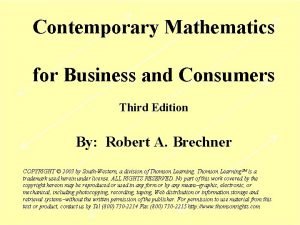Management A Practical Introduction Third Edition Angelo Kinicki

















































- Slides: 49

Management A Practical Introduction Third Edition Angelo Kinicki & Brian K. Williams Kinicki/Williams, Management: A Practical Introduction 3 e © 2008, Mc. Graw-Hill/Irwin

Chapter 5: Planning The Foundation of Successful Management v. Planning & Uncertainty v. Fundamentals of Planning v. The Planning/Control Cycle v. Management by Objectives v. Project Planning Kinicki/Williams, Management: A Practical Introduction 3 e © 2008, Mc. Graw-Hill/Irwin 2

5. 1 Planning & Uncertainty HOW CAN PLANNING HELP MANAGERS DEAL WITH UNCERTAINTY? v Planning: defined as setting goals and deciding how to achieve them v Another definition: Planning is coping with uncertainty by formulating future courses of action to achieve specified results. Kinicki/Williams, Management: A Practical Introduction 3 e © 2008, Mc. Graw-Hill/Irwin 3

5. 1 Planning & Uncertainty HOW CAN PLANNING HELP MANAGERS DEAL WITH UNCERTAINTY? v. Planning is used together with strategic management and evolves from the company’s mission and vision v. Planning covers strategic planning (done by top managers, tactical planning (done by middle managers), and operational planning (done by first-line managers) Kinicki/Williams, Management: A Practical Introduction 3 e © 2008, Mc. Graw-Hill/Irwin 4

5. 1 Planning & Uncertainty Figure 5. 1: Planning and Strategic Management Kinicki/Williams, Management: A Practical Introduction 3 e © 2008, Mc. Graw-Hill/Irwin 5

5. 1 Planning & Uncertainty WHY NOT PLAN? Managers need to be cautious when planning for two reasons: 1. Planning requires managers to set aside their regular responsibilities to develop plans 2. Managers need to be flexible enough to react to new events because there may not always be enough time to plan Kinicki/Williams, Management: A Practical Introduction 3 e © 2008, Mc. Graw-Hill/Irwin 6

5. 1 Planning & Uncertainty HOW DOES PLANNING HELP? There are four main benefits of planning: 1. Organizations can use plans to check their progress toward their goals 2. Plans define the responsibilities of a firm’s departments and coordinates their activities 3. Planning requires managers to consider what may happen in the future 4. Planning for unpleasant contingencies helps managers deal with uncertainty Kinicki/Williams, Management: A Practical Introduction 3 e © 2008, Mc. Graw-Hill/Irwin 7

Why not plan? v Planning requires you to set aside time to do it v Most managers are time-starved v Hard to set aside time to plan v You may have to make some decisions without a lot of time to plan v Even in today’s computer age, you may not have time to plan a decision v Plan need not be perfect to be executable Mc. Graw-Hill/Irwin Kinicki/Williams, Management: A Practical Introduction 3 e © 2008, Mc. Graw-Hill/Irwin © 2006 The Mc. Graw-Hill Companies, Inc. All rights reserved. 8

The Benefits of Planning 1) Planning helps you check on your progress 2) Planning helps you coordinate activities 3) Planning helps you think ahead 4) Above all, planning helps you cope with uncertainty Mc. Graw-Hill/Irwin Kinicki/Williams, Management: A Practical Introduction 3 e © 2008, Mc. Graw-Hill/Irwin © 2006 The Mc. Graw-Hill Companies, Inc. All rights reserved. 9

5. 1 Planning & Uncertainty There are three types of uncertainty: 1. State Uncertainty 2. Effect Uncertainty 3. Response Uncertainty Kinicki/Williams, Management: A Practical Introduction 3 e © 2008, Mc. Graw-Hill/Irwin 10

Three Types of Uncertainty “What possible harmful event could occur? ” v State Uncertainty: when the environment is considered unpredictable. v Example: the uncertainty regarding the weather Mc. Graw-Hill/Irwin Kinicki/Williams, Management: A Practical Introduction 3 e © 2008, Mc. Graw-Hill/Irwin © 2006 The Mc. Graw-Hill Companies, Inc. All rights reserved. 11

Three Types of Uncertainty “What possible harmful impact might an environmental change have? ” v Effect Uncertainty: when the effects of environmental changes are unpredictable. v Example: losing the trail in a snowstorm and risking hypothermia. Mc. Graw-Hill/Irwin Kinicki/Williams, Management: A Practical Introduction 3 e © 2008, Mc. Graw-Hill/Irwin © 2006 The Mc. Graw-Hill Companies, Inc. All rights reserved. 12

Three Types of Uncertainty “What possible harmful consequence might a decision have? ” v Response Uncertainty: when the consequences of a decision are uncertain. v Example: you might have a cell phone in a snowstorm, but someone has to receive the call. Mc. Graw-Hill/Irwin Kinicki/Williams, Management: A Practical Introduction 3 e © 2008, Mc. Graw-Hill/Irwin © 2006 The Mc. Graw-Hill Companies, Inc. All rights reserved. 13

Chapter 5: Planning CLASSROOM PERFORMANCE SYSTEM A firm that is analyzing what possible harmful event could occur is looking at A) response uncertainty B) effect uncertainty C) defense uncertainty D) state uncertainty Kinicki/Williams, Management: A Practical Introduction 3 e © 2008, Mc. Graw-Hill/Irwin 14

Chapter 5: Planning CLASSROOM PERFORMANCE SYSTEM A firm that is analyzing what possible harmful event could occur is looking at A) response uncertainty B) effect uncertainty C) defense uncertainty D) state uncertainty Kinicki/Williams, Management: A Practical Introduction 3 e © 2008, Mc. Graw-Hill/Irwin 15

5. 1 Planning & Uncertainty Raymond E. Miles and Charles C. Snow suggested that firms will adopt one of four strategies to respond to uncertainty: 1. Defenders 2. Prospectors 3. Analyzers 4. Reactors Kinicki/Williams, Management: A Practical Introduction 3 e © 2008, Mc. Graw-Hill/Irwin 16

Responding to Uncertainty v Defenders: are expert at producing and selling narrowly defined products and services. v Mc. Graw-Hill/Irwin Prospectors: focus on developing new markets or services and in seeking out new markets rather than waiting for things to happen. v Analyzers: let the other organizations take the risks of product development and marketing and then imitate what seems to work best. v Reactors: make adjustments only when finally forced to by environmental pressures. Kinicki/Williams, Management: A Practical Introduction 3 e © 2008, Mc. Graw-Hill/Irwin © 2006 The Mc. Graw-Hill Companies, Inc. All rights reserved. 17

5. 1 Planning & Uncertainty Miles and Snow also argued that firms continuously make decisions about three kinds of business problems: 1. entrepreneurial - selecting and making adjustments of products and markets 2. engineering - producing and delivering the products 3. administrative - establishing roles, relationships, and organizational processes Kinicki/Williams, Management: A Practical Introduction 3 e © 2008, Mc. Graw-Hill/Irwin 18

5. 2 Fundamentals Of Planning WHAT IS INVOLVED WITH PLANNING? v. Planning translates an organization’s mission (purpose or reason for being) into objectives v. The mission statement answers the question “what is our reason for being? ” v. The vision statement answers the questions “what do we want to become where do we want to go strategically? ” v. Planning begins with the mission statement Kinicki/Williams, Management: A Practical Introduction 3 e © 2008, Mc. Graw-Hill/Irwin 20

Mission Statement v Outline of the fundamental purposes of the organization v Should address: v Organization’s self-concept v Company philosophy and goals v Long-term survival v Customer needs v Social responsibility v Nature of company’s product or service Mc. Graw-Hill/Irwin Kinicki/Williams, Management: A Practical Introduction 3 e © 2008, Mc. Graw-Hill/Irwin © 2006 The Mc. Graw-Hill Companies, Inc. All rights reserved. 21

The World Bank’s Mission 1) In the last chapter, we learned about the World Bank. 2) Go to http: //web. worldbank. org 3) Explore the “about us” section 4) What is the World Bank’s mission? 5) Does this mission statement meet the criterion laid out in this chapter? Mc. Graw-Hill/Irwin Kinicki/Williams, Management: A Practical Introduction 3 e © 2008, Mc. Graw-Hill/Irwin © 2006 The Mc. Graw-Hill Companies, Inc. All rights reserved. 22

5. 2 Fundamentals Of Planning Figure 5. 2: Making Plans Kinicki/Williams, Management: A Practical Introduction 3 e © 2008, Mc. Graw-Hill/Irwin 23

5. 2 Fundamentals Of Planning Having clearly defined mission and vision statements allows three things to happen: 1. strategic planning by top management where longterm goals are determined and available resources are identified 2. tactical planning by middle management where contributions their departments or similar work units can make are determined 3. operational planning by first-line managers where how specific tasks will be accomplished using available resources is determined Kinicki/Williams, Management: A Practical Introduction 3 e © 2008, Mc. Graw-Hill/Irwin 24

Types of Planning v Strategic planning: top managers decide what the organization’s longterm goals should be for the next 1 -5 years with the resources they expect to have available. v Tactical planning: middle managers decide what contributions their departments or similar work units can make with their given resources during the next 6 -24 months. v Operational planning: first-line managers determine how to accomplish specific tasks with available resources within the next 152 weeks. Mc. Graw-Hill/Irwin Kinicki/Williams, Management: A Practical Introduction 3 e © 2008, Mc. Graw-Hill/Irwin © 2006 The Mc. Graw-Hill Companies, Inc. All rights reserved. 25

5. 2 Fundamentals Of Planning Figure 5. 3: Three Levels of Management, Three Types of Planning Kinicki/Williams, Management: A Practical Introduction 3 e © 2008, Mc. Graw-Hill/Irwin 26

5. 2 Fundamentals Of Planning v. The purpose of planning is to set goals and then formulate action plans v. Specific commitments to achieve a measurable result within a stated period of time are known as goals or objectives v. Goals are put in a means-end chain where the achievement of objectives is the means to achieve goals or ends Kinicki/Williams, Management: A Practical Introduction 3 e © 2008, Mc. Graw-Hill/Irwin 27

Types of Goals v v v Strategic Goals: are set by and for top management and focus on objectives for the organization as a whole. Tactical Goals: are set by and for middle managers and focus on the actions needed to achieve strategic goals. Operational Goals: are set by and for first-line managers and are concerned with short-tem matters associated with realizing tactical goals. Mc. Graw-Hill/Irwin Kinicki/Williams, Management: A Practical Introduction 3 e © 2008, Mc. Graw-Hill/Irwin © 2006 The Mc. Graw-Hill Companies, Inc. All rights reserved. 28

Chapter 5: Planning CLASSROOM PERFORMANCE SYSTEM Goals set by top management that focus on objectives for the organization as a whole are A) tactical goals B) operational goals C) strategic goals D) organizational goals Kinicki/Williams, Management: A Practical Introduction 3 e © 2008, Mc. Graw-Hill/Irwin 29

Chapter 5: Planning CLASSROOM PERFORMANCE SYSTEM Goals set by top management that focus on objectives for the organization as a whole are A) tactical goals B) operational goals C) strategic goals D) organizational goals Kinicki/Williams, Management: A Practical Introduction 3 e © 2008, Mc. Graw-Hill/Irwin 30

5. 2 Fundamentals Of Planning v. Once goals are set, the firm makes an action plan which defines the course of action needed to achieve stated goals v. An operating plan defines how the firm will conduct business based on the action plan - it identifies clear targets such as revenues, cash flow, and market share v. Plans developed for activities that occur repeatedly over a period of time are called standing plans v. Standing plans consist of policies (a standing plan that outlines the general response to a designated problem or situation), procedures (a standing plan that outlines the response to a particular problem or circumstance), and rules (a standing plan that designates specific required action) Kinicki/Williams, Management: A Practical Introduction 3 e © 2008, Mc. Graw-Hill/Irwin 31

Chapter 5: Planning CLASSROOM PERFORMANCE SYSTEM “No smoking anywhere in the building” is an example of a A) policy B) procedure C) rule D) request Kinicki/Williams, Management: A Practical Introduction 3 e © 2008, Mc. Graw-Hill/Irwin 32

Chapter 5: Planning CLASSROOM PERFORMANCE SYSTEM “No smoking anywhere in the building” is an example of a A) policy B) procedure C) rule D) request Kinicki/Williams, Management: A Practical Introduction 3 e © 2008, Mc. Graw-Hill/Irwin 33

5. 2 Fundamentals Of Planning v. Plans developed for activities that are not likely to be repeated in the future are called single-use plans v. Single-use plans can be either programs (encompass a range of projects or activities) or projects (have less scope and complexity than a program) Kinicki/Williams, Management: A Practical Introduction 3 e © 2008, Mc. Graw-Hill/Irwin 34

5. 2 Fundamentals Of Planning WHAT ARE SMART GOALS? Good goals are SMART: vthey should be stated in specific terms vthey should be measurable or quantifiable vthey should be challenging but attainable vthey should be results-oriented and support the organization’s vision vthey should specify target dates by which they should be accomplished Kinicki/Williams, Management: A Practical Introduction 3 e © 2008, Mc. Graw-Hill/Irwin 35

Chapter 5: Planning CLASSROOM PERFORMANCE SYSTEM Good goals should have all of the following characteristics except A) results-oriented B) target date C) supportive D) attainable Kinicki/Williams, Management: A Practical Introduction 3 e © 2008, Mc. Graw-Hill/Irwin 36

Chapter 5: Planning CLASSROOM PERFORMANCE SYSTEM Good goals should have all of the following characteristics except A) results-oriented B) target date C) supportive D) attainable Kinicki/Williams, Management: A Practical Introduction 3 e © 2008, Mc. Graw-Hill/Irwin 37

5. 3 The Planning/Control Cycle WHY HAVE PLANNING AND CONTROL? v. Once an organization has a plan, it needs to make sure it stays on track v. The planning/control cycle has two planning steps, and two control steps: vplanning steps: make the plan, and carry out the plan vcontrol steps: control the direction by comparing results with the plan, and control the direction by taking corrective actions Kinicki/Williams, Management: A Practical Introduction 3 e © 2008, Mc. Graw-Hill/Irwin 38

Chapter 5: Planning Figure 5. 5: The Planning/Control Cycle Kinicki/Williams, Management: A Practical Introduction 3 e © 2008, Mc. Graw-Hill/Irwin 39

5. 4 Promoting Goal Setting: Management By Objectives HOW CAN MANAGERS PROMOTE GOAL SETTING? v. Peter Drucker developed a system called Management by Objectives (MBO) designed to motivate employees to achieve goals v. MBO has four steps: 1. Managers and employees jointly set objectives for the employee v. Goals should include improvement objectives, personal development objectives, and maintenance objectives Kinicki/Williams, Management: A Practical Introduction 3 e © 2008, Mc. Graw-Hill/Irwin 40

5. 4 Promoting Goal Setting: Management By Objectives 2. Managers develop action plans v. Action plans should be developed at each level describing how goals will be attained 3. Managers and employees periodically review the employee’s performance v. Formal and informal meetings are used to review progress and provide feedback 4. The manager makes a performance appraisal and rewards the employee according to the results v. Performance that meets objectives should be rewarded, and poor performance should be addressed Kinicki/Williams, Management: A Practical Introduction 3 e © 2008, Mc. Graw-Hill/Irwin 41

5. 4 Promoting Goal Setting: Management By Objectives If MBO is to be successful, three things must occur: 1. Top management must be committed v. Commitment translates to productivity gains 2. It must be applied organization-wide v. To be successful, MBO must be applied in all divisions and departments 3. Objectives must cascade v. MBO works by cascading objectives down through the organization Kinicki/Williams, Management: A Practical Introduction 3 e © 2008, Mc. Graw-Hill/Irwin 42

Three Types of Objectives Used in MBO v Improvement objectives: Increase sport utility sales by 10% v Personal development objectives: attend five days of leadership training v Maintenance objectives: continue to meet the increased sales goals specified last quarter Mc. Graw-Hill/Irwin Kinicki/Williams, Management: A Practical Introduction 3 e © 2008, Mc. Graw-Hill/Irwin © 2006 The Mc. Graw-Hill Companies, Inc. All rights reserved. 43

5. 5 Project Planning WHAT IS PROJECT PLANNING? v. The preparation of single-use plans or projects is called project planning v. Project management involves achieving a set of goals through planning, scheduling, and maintaining progress of the activities that comprise the project v. Project planning reduces the risk of uncertainty and speeds up the process of getting things done Kinicki/Williams, Management: A Practical Introduction 3 e © 2008, Mc. Graw-Hill/Irwin 44

Why Project Planning Is Important Today 1. Project Planning 1. Preparation of single-use plans or projects, followed by… 2. Project Management 1. Achieving a set of goals through planning, scheduling, and maintaining progress of the activities that comprise the project 2. Fastest way of getting things done 3. Works outside usual chain of command 4. Brings people with different skills together on a temporary basis Mc. Graw-Hill/Irwin Kinicki/Williams, Management: A Practical Introduction 3 e © 2008, Mc. Graw-Hill/Irwin © 2006 The Mc. Graw-Hill Companies, Inc. All rights reserved. 45

5. 5 Project Planning Figure 5. 6: The Project Life Cycle Kinicki/Williams, Management: A Practical Introduction 3 e © 2008, Mc. Graw-Hill/Irwin 46

5. 5 Project Planning All projects go through a life cycle: 1. In the definition stage, the problem is stated, assumptions and risks are identified, goals and objectives are determined, and the budget and schedule are set 2. In the planning stage, facilities and equipment are identified, people and their duties are selected, and the schedule is considered 3. During the execution stage, the management style and control tools are established 4. Closing occurs when the client accepts the project Kinicki/Williams, Management: A Practical Introduction 3 e © 2008, Mc. Graw-Hill/Irwin 47

The Project Life Cycle: The Predictable Evolution of a Project 1. Definition 1. State the problem and identify goals and objectives 2. Planning 1. Identify resources needed and schedule of activities required 3. Execution 1. Actual work stage 2. On time and under budget 4. Closing 1. Client accepts project Mc. Graw-Hill/Irwin Kinicki/Williams, Management: A Practical Introduction 3 e © 2008, Mc. Graw-Hill/Irwin © 2006 The Mc. Graw-Hill Companies, Inc. All rights reserved. 48

Chapter 5: Planning CLASSROOM PERFORMANCE SYSTEM At what stage in the project life cycle is the budget determined? A) definition B) planning C) execution D) closing Kinicki/Williams, Management: A Practical Introduction 3 e © 2008, Mc. Graw-Hill/Irwin 49

5. 5 Project Planning WHY IS PROJECT PLANNING IMPORTANT? v. Deadlines are an essential component in the project planning process v. Deadlines help keep managers on track and provide feedback Kinicki/Williams, Management: A Practical Introduction 3 e © 2008, Mc. Graw-Hill/Irwin 50
 Kinicki management a practical introduction
Kinicki management a practical introduction Management a practical introduction
Management a practical introduction Materi manajemen perubahan
Materi manajemen perubahan Greenberrg
Greenberrg Read management: a practical introduction online
Read management: a practical introduction online Management: a practical introduction
Management: a practical introduction Management a practical introduction 3e
Management a practical introduction 3e Gj mount classification of dental caries
Gj mount classification of dental caries Odontoclasia meaning
Odontoclasia meaning Principles of economics third edition oxford pdf
Principles of economics third edition oxford pdf Reaction of grignard reagent with acid chloride
Reaction of grignard reagent with acid chloride Organic chemistry third edition david klein
Organic chemistry third edition david klein Business mathematics third edition
Business mathematics third edition Modern operating systems tanenbaum
Modern operating systems tanenbaum Fundamentals of corporate finance canadian edition
Fundamentals of corporate finance canadian edition Sujata madan
Sujata madan Lifespan development third edition
Lifespan development third edition Lifespan development third edition
Lifespan development third edition Essential cell biology
Essential cell biology Joey's first 14 quiz grades in a marking period were
Joey's first 14 quiz grades in a marking period were Introduction to management information systems 5th edition
Introduction to management information systems 5th edition Using mis 10th edition
Using mis 10th edition Report
Report Introduction in practical research 2
Introduction in practical research 2 Angelo carrieri
Angelo carrieri San angelo panhellenic
San angelo panhellenic Angelo vecchi
Angelo vecchi Aakash bavishi
Aakash bavishi Angelo buono 2000
Angelo buono 2000 What is the general profile for a serial killer
What is the general profile for a serial killer Angelo gadina
Angelo gadina Angelo corallo unisalento
Angelo corallo unisalento Angelo mario venditti
Angelo mario venditti Adam d'angelo
Adam d'angelo San angelo panhellenic
San angelo panhellenic Campus connect cisco college
Campus connect cisco college Sally d'angelo torrent
Sally d'angelo torrent Angelo farina
Angelo farina Tartaglia triangolo
Tartaglia triangolo Angelo tartaglia politecnico torino
Angelo tartaglia politecnico torino If maribel a groupmate of angelo in number 2
If maribel a groupmate of angelo in number 2 Angelo voulgaris
Angelo voulgaris Endo sealer containing polyketone
Endo sealer containing polyketone Elizabeth archer south africa
Elizabeth archer south africa Il varco per montale
Il varco per montale Dr maya angelo
Dr maya angelo Angelo angeletti
Angelo angeletti 50 cats by angelo and cross
50 cats by angelo and cross Mark angelo md
Mark angelo md Adriana dangelo
Adriana dangelo




































































